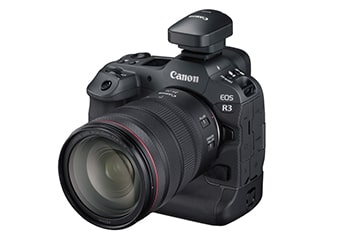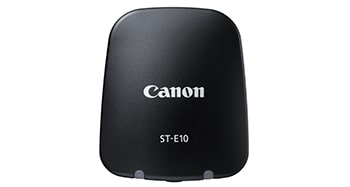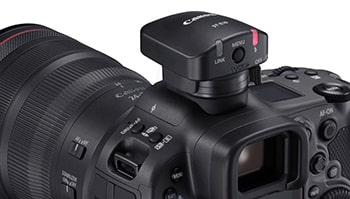Explore null | Canon Latin America

Speedlite Transmitter ST-E10
- Speedlite Transmitter ST-E10
- Shoe Cap
- Case
-
OVERVIEW
-
SPECIFICATIONS
-
ACCESSORIES
-
RESOURCES
-
SUPPORT
-
MISCELLANEOUS
For wireless Speedlite setups requiring one or more off-camera flashes, the Speedlite Transmitter ST-E10 delivers a transmitter compatible with EOS cameras that include the multi-function shoe. Since this transmitter maintains a digital connection to the camera through the shoe, it does not require batteries, making the design approximately 30% smaller and approximately 50% lighter (than the ST-E3-RT II). Controlling and changing the 5 independent groups across 15 Speedlites is as easy as pressing the menu button located on the transmitter and adjusting the settings from the vari-angle touchscreen on the back of the camera, or with the flash setting screen when using the Canon Camera Connect app on your smartphone. With full flash control at your fingertips, the Speedlite Transmitter ST-E10 is an indispensable tool for advanced, professional flash photography.
Using the multifunction hotshoe of compatible cameras, the Speedlite Transmitter ST-E10 gets its power from the camera itself, eliminating the need to remember to power off the transmitter or remembering to change batteries before a shoot.

In comparison to the ST-E3-RT II transmitter, the Speedlite Transmitter ST-E10 is approximately 30% smaller and approximately 50% lighter, taking up less room in the camera bag.

To change settings and control the off-camera Speedlites, simply press the menu button on the back of the transmitter and use the touchscreen on the back of the camera to manage all of your flash settings.

When connected to Canon’s Camera Connect app, you have the ability to change all of your settings from the flash setting screen on your smartphone with an intuitive and familiar tap and swipe.
Much more reliable than traditional line-of-sight transmission, the Speedlite Transmitter ST-E10 has a secure and constant 2-way communication with each individual Speedlite and Speedlite group, enabling changing settings such as mode, power, ratio changes, recycle status and more across a distance of up to 98.4 feet (30 meters).
- Windows Server 2025
- macOS 14
- macOS 13
- Windows 11
- macOS 12
- Windows Server 2022
- macOS 11
- Linux MIPS
- Linux ARM
- macOS 10.15
- macOS v10.13
- macOS v10.14
- Windows Server 2019 (x64)
- macOS v10.14
- macOS v10.13
- Windows Server 2016 (x64)
- macOS Sierra v10.12
- Linux 64bit
- Linux 32bit
- OS X v10.11
- Windows 10
- Windows 10 (x64)
- OS X v10.10
- OS X v10.9
- Windows Server 2012 R2 (x64)
- Windows 8.1 (x64)
- Windows 8.1
- Windows Server 2012 (x64)
- Windows 8
- Windows 8 (x64)
- Windows 7
- Windows 7 (x64)
- Windows Vista
- Windows Vista (x64)
- Windows XP
- Windows XP (x64)
- Windows Server 2008
- Windows Server 2008 (x64)
- Windows Server 2008 R2 (x64)
- Windows Server 2003
- Windows Server 2003 (x64)
- Windows Server 2003 R2
- Windows Server 2003 R2 (x64)
- Windows 2000
- Windows NT
- Windows 3.1
- Windows Me
- Windows 98
- Windows 95
- Mac OS X v10.8
- Mac OS X v10.7
- Mac OS X v10.6
- Mac OS X v10.5
- Mac OS X v10.4
- Mac OS X v10.3
- Mac OS X v10.2
- Mac OS X v10.1
- Mac OS X
- Mac OS 9
- Mac OS 8
- Linux (x64)
- Linux (x32)
- Linux
Locating and installing your download Locating and installing your download ES Locating and installing your download PT
How to identify your OS version
To help determine which Windows operating system is running on your computer, please view the below steps:
Windows 11
Click on the Windows button (located left to the Search at the bottom).
Click on the Settings button to navigate to the system settings.
Scroll to the bottom of the page and click on the About button.
You will be able to find your Windows operating system under the Windows Specifications section.
Windows® 10
Click Start or click the Windows button (usually found in the lower-left corner of your screen).
Click Settings.
Click About (which is usually located within the lower left of the screen). The next screen should display the Windows version.
Windows 8 or Windows 8.1
Option1: Swipe in from the upper-right corner of the screen while viewing the desktop in order to open the menu, then select Settings.
Select PC Info. Under Windows edition, the Windows version is shown.
Option 2: From the Start Screen
While on the Start screen, type computer.
Right-click on the computer icon. If using touch, press and hold on the computer icon.
Click or tap Properties. Under Windows edition, the Windows version is shown.
Windows 7
Click Start or click the Windows button (usually found in the lower-left corner of your screen).
Right-click Computer and select Properties from the menu. The resulting screen should now display the Windows version.
Linux
To check the version of your Linux operating system (OS), you can use the following commands in your terminal:
1. uname -r: Displays your Linux kernel version.
2. cat /etc/os-release: Displays your distribution name and version.
3. lsb_release -a: Displays specific details about your Linux distribution and version.
4. You can also use the hostnamectl command to display the Linux kernel version. However, this command is only available on Linux distributions that use systemd by default.
To help determine which Mac operating system is running on your computer, select the Apple menu in the upper-left corner of your screen and choose About This Mac.
Upon selecting, you should see the macOS name followed by the version number.
Canon U.S.A Inc. All Rights Reserved. Reproduction in whole or part without permission is prohibited.